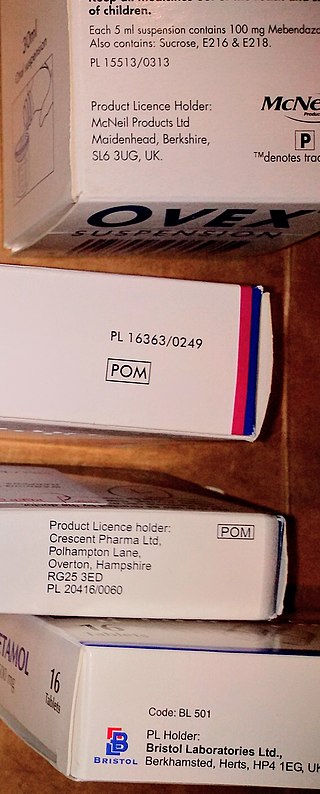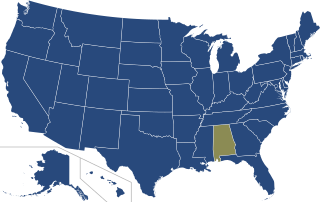Related Research Articles

Over-the-counter (OTC) drugs are medicines sold directly to a consumer without a requirement for a prescription from a healthcare professional, as opposed to prescription drugs, which may be supplied only to consumers possessing a valid prescription. In many countries, OTC drugs are selected by a regulatory agency to ensure that they contain ingredients that are safe and effective when used without a physician's care. OTC drugs are usually regulated according to their active pharmaceutical ingredient (API) rather than final products. By regulating APIs instead of specific drug formulations, governments allow manufacturers the freedom to formulate ingredients, or combinations of ingredients, into proprietary mixtures.

A pharmacist, also known as a chemist or a druggist, is a healthcare professional who dispenses medications and who provides advice on their effective use, with the aim of preventing disease and promoting public health. Pharmacists often serve as primary care providers in the community, and may offer other services such as health screenings and immunizations.

Pharmacy is the science and practice of discovering, producing, preparing, dispensing, reviewing and monitoring medications, aiming to ensure the safe, effective, and affordable use of medicines. It is a miscellaneous science as it links health sciences with pharmaceutical sciences and natural sciences. The professional practice is becoming more clinically oriented as most of the drugs are now manufactured by pharmaceutical industries. Based on the setting, pharmacy practice is either classified as community or institutional pharmacy. Providing direct patient care in the community of institutional pharmacies is considered clinical pharmacy.

A prescription, often abbreviated ℞ or Rx, is a formal communication from a physician or other registered health-care professional to a pharmacist, authorizing them to dispense a specific prescription drug for a specific patient. Historically, it was a physician's instruction to an apothecary listing the materials to be compounded into a treatment—the symbol ℞ comes from the first word of a medieval prescription, Latin: Recipere, that gave the list of the materials to be compounded.

A prescription drug is a pharmaceutical drug that is only permitted to be dispensed to those with a medical prescription. In contrast, over-the-counter drugs can be obtained without a prescription. The reason for this difference in substance control is the potential scope of misuse, from drug abuse to practicing medicine without a license and without sufficient education. Different jurisdictions have different definitions of what constitutes a prescription drug.
An independent pharmacy is a retail pharmacy that is not directly affiliated with any chain of pharmacies and is not owned by a publicly traded company. Independent pharmacies are pharmacist-owned, privately held businesses in varying practice settings. They include single-store operations, pharmacist-owned multiple store locations, franchise, compounding, long-term care (LTC), specialty, and supermarket pharmacy operation. Independent pharmacy owners generally have more flexibility to build personalized customer relationships and they strive to differentiate their services from big-chain corporations.
IntercomPlus is the Walgreen Company's proprietary pharmacy computer system. It was founded as Intercom in 1981, and was the first large scale retail pharmacy computer system. It relies on VSAT satellite access and/or broadband connections to link the over 8,000 Walgreens retail, mail service, and specialty pharmacies. Through its usage, Intercom made Walgreens the largest private user of satellite transmission data in the world, second only to the U.S. Government. The design of the system enables seamless store-to-store prescription filling, making filling a refill at a location other than where it was filled originally essentially no different from filling it again at the original location.

Thrifty White Pharmacy is an American pharmacy chain with operations in six states, Montana, North Dakota, South Dakota, Minnesota, Wisconsin, and Iowa headquartered in Plymouth, MN. The firm specializes in filling prescriptions, long term care consulting, community outreach, and specialty services. As of September 2016, Thrifty White received full URAC accreditation for its specialty pharmacy.
Pharmaceutical policy is a branch of health policy that deals with the development, provision and use of medications within a health care system. It embraces drugs, biologics, vaccines and natural health products.
A veterinary pharmacist is a specially trained pharmacist who dispenses veterinary drugs and supplies or products and advice to owners of companion animals and livestock. In addition, they advise the regulatory bodies and are involved in the formulation of veterinary drugs. Veterinary pharmacy is a field of pharmacy practice, in which veterinary pharmacists may compound medications, fill prescriptions, and manage drug therapies for animals. Veterinary pharmacists are licensed pharmacists who specialize in the distribution of medications for animals.

Clinical pharmacy is the branch of pharmacy in which clinical pharmacists provide direct patient care that optimizes the use of medication and promotes health, wellness, and disease prevention. Clinical pharmacists care for patients in all health care settings but the clinical pharmacy movement initially began inside hospitals and clinics. Clinical pharmacists often work in collaboration with physicians, physician assistants, nurse practitioners, and other healthcare professionals. Clinical pharmacists can enter into a formal collaborative practice agreement with another healthcare provider, generally one or more physicians, that allows pharmacists to prescribe medications and order laboratory tests.

A pharmacy is a retail shop which provides pharmaceutical drugs, among other products. At the pharmacy, a pharmacist oversees the fulfillment of medical prescriptions and is available to counsel patients about prescription and over-the-counter drugs or about health problems and wellness issues. A typical pharmacy would be in the commercial area of a community.
Electronic prescription is the computer-based electronic generation, transmission, and filling of a medical prescription, taking the place of paper and faxed prescriptions. E-prescribing allows a physician, physician assistant, pharmacist, or nurse practitioner to use digital prescription software to electronically transmit a new prescription or renewal authorization to a community or mail-order pharmacy. It outlines the ability to send error-free, accurate, and understandable prescriptions electronically from the healthcare provider to the pharmacy. E-prescribing is meant to reduce the risks associated with traditional prescription script writing. It is also one of the major reasons for the push for electronic medical records. By sharing medical prescription information, e-prescribing seeks to connect the patient's team of healthcare providers to facilitate knowledgeable decision making.
Medication therapy management, generally called medicine use review in the United Kingdom, is a service provided typically by pharmacists that aims to improve outcomes by helping people to better understand their health conditions and the medications used to manage them. This includes providing education on the disease state and medications used to treat the disease state, ensuring that medicines are taken correctly, reducing waste due to unused medicines, looking for any side effects, and providing education on how to manage any side effects. The process that can be broken down into five steps: medication therapy review, personal medication record, medication-related action plan, intervention and or referral, and documentation and follow-up.

Remote dispensing is used in health care environments to describe the use of automated systems to dispense prescription medications without an on-site pharmacist. This practice is most common in long-term care facilities and correctional institutions that do not find it practical to operate a full-service in-house pharmacy.
Electronic Prescriptions for Controlled Substances (EPCS) was originally a proposal for the DEA to revise its regulations to provide practitioners with the option of writing electronic prescriptions for controlled substances. These regulations would also permit pharmacies to receive, dispense, and archive these electronic prescriptions. These proposed regulations would be an addition to, not a replacement of, the existing rule.
Separation of prescribing and dispensing, also called dispensing separation, is a practice in medicine and pharmacy in which the physician who provides a medical prescription is independent from the pharmacist who provides the prescription drug.

A collaborative practice agreement (CPA) is a legal document in the United States that establishes a legal relationship between clinical pharmacists and collaborating physicians that allows for pharmacists to participate in collaborative drug therapy management (CDTM).

The pharmacy management system, also known as the pharmacy information system, is a system that stores data and enables functionality that organizes and maintains the medication use process within pharmacies.

Drug utilization review refers to a review of prescribing, dispensing, administering and ingesting of medication. This authorized, structured and ongoing review is related to pharmacy benefit managers. Drug use/ utilization evaluation and medication utilization evaluations are the same as drug utilization review.
References
- 1 2 "U.S. National Pharmacy Market Summary". OneKey by IQVIA. July 2019.
- ↑ Qato, Dima Mazen; Zenk, Shannon; Wilder, Jocelyn; Harrington, Rachel; Gaskin, Darrell; Alexander, G. Caleb (2017-08-16). "The availability of pharmacies in the United States: 2007–2015". PLOS ONE. 12 (8): e0183172. doi: 10.1371/journal.pone.0183172 . ISSN 1932-6203. PMC 5559230 . PMID 28813473.
- ↑ says, Dean Reardon (2016-09-06). "Community Pharmacy". News-Medical.net. Retrieved 2020-12-13.
- ↑ "By the numbers: How community pharmacists measure up". Drug Store News. Retrieved 2020-12-13.
- 1 2 "Getting a prescription filled: MedlinePlus Medical Encyclopedia". medlineplus.gov. Retrieved 2021-01-06.
- 1 2 3 "Drug Utilization Review | AMCP.org". www.amcp.org. Retrieved 2021-01-15.
- 1 2 3 "The Community Pharmacist as a Provider of Immunizations". Pharmacy Times. Retrieved 2021-05-16.
- 1 2 "The Impact of Community Pharmacies on Immunization". Pharmacy Times. Retrieved 2021-05-16.
- 1 2 Vaccinating Adults: A Step-by-Step Guide. Immunization Action Coalition. 2017. ISBN 978-0-692-94976-4.
- ↑ "State Public Health | ASTHO". www.astho.org. Retrieved 2021-05-16.